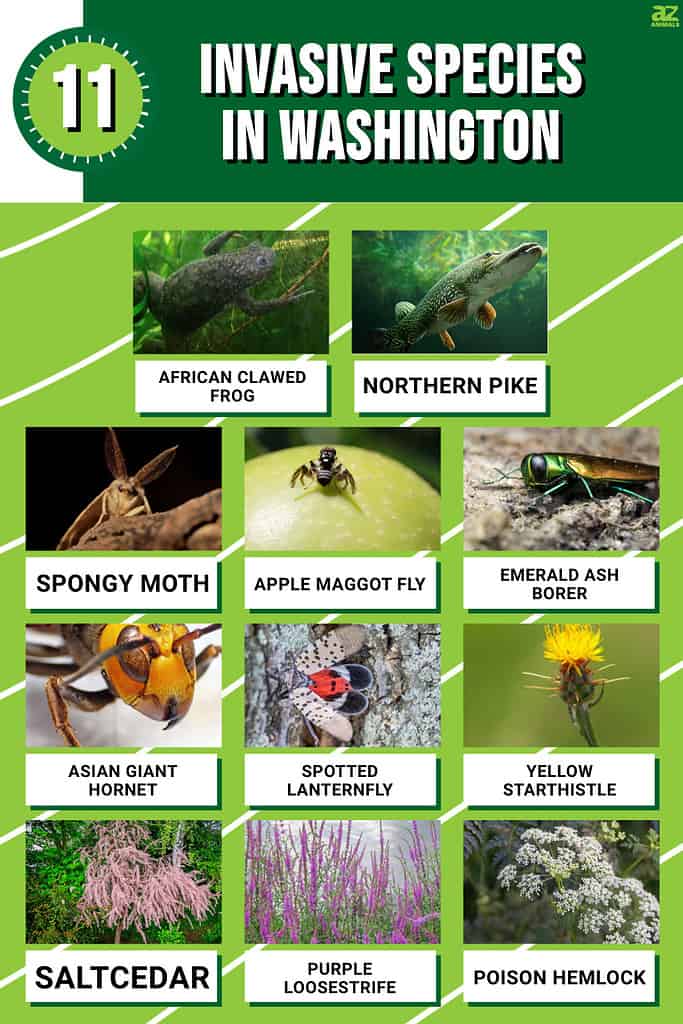
Washington is a state full of various flora and fauna. Unfortunately, many invasive species also call the state home. These species threaten native species and habitats and can cause significant damage to the ecosystem. By recognizing these invasive species, you can play a part in stopping the invasion and adverse effects of these species.
Let’s get to know 11 of these invasive species in Washington.
African Clawed Frog (Xenopus laevis)
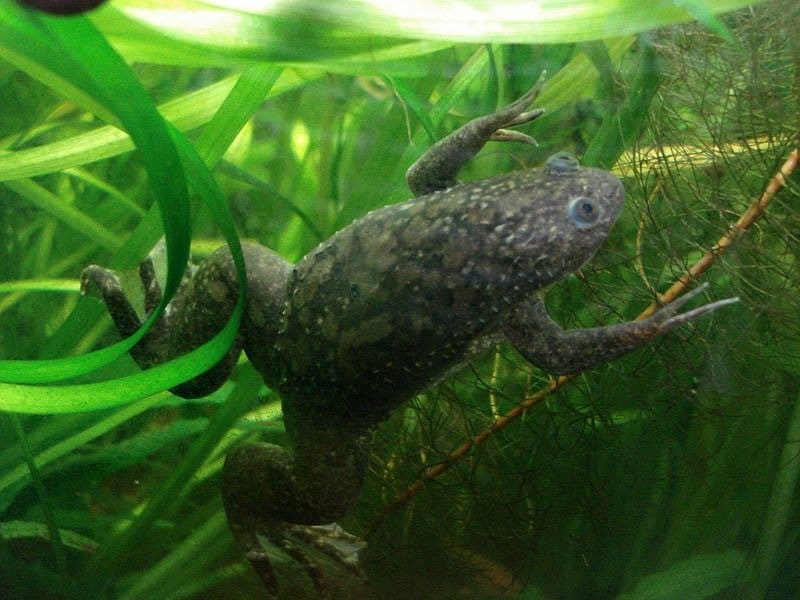
Native to
Africa
, the African clawed frog outcompetes native species for resources.
©Pouzin Olivier / CC BY-SA 3.0 – License
The African clawed frog is native to Africa and is now found in North America, South America, Europe, and Asia. These amphibians are semi-aquatic with small heads and flattened bodies. Their skin is smooth, often mottled, and greenish-grey in color with white abdomens. These frogs are unique due to their three short claws on each hind foot. They use these claws to tear apart their food. These frogs can grow up to 4.7 inches in length and weigh around 7 ounces.
This frog is carnivorous and will eat whatever it can fit into its mouth. This includes water bugs, fish, insects, spiders, worms, and even their own tadpoles! The African clawed frog is invasive because it outcompetes native species for resources. This frog is also able to introduce harmful pathogens. An infestation of this species can decrease recreational fishing potential.
Control measures for the African clawed frog are necessary. In Washington, these frogs are classified as prohibited. This means the African clawed frog cannot be possessed, purchased, sold, or transported. These frogs can only be caught or killed by a few methods – angling, hand dip netting, spearing, or with a bow and arrow.
Northern Pike (Esox lucius)
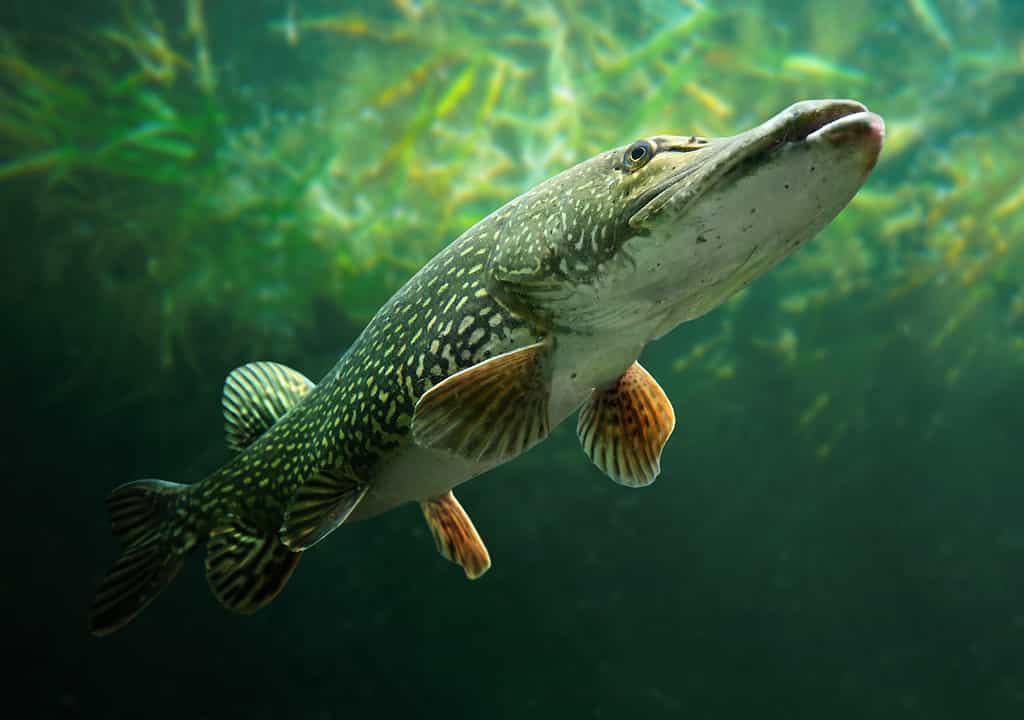
Illegally introduced in the 50s, the northern pike is aggressive in nature.
©iStock.com/abadonian
The northern pike is native to northern regions of the world, including North America, Europe, and Asia, and has since spread to many other rivers and lakes around the world. They are medium-sized freshwater fish with large mouths filled with sharp teeth. Their bodies are long and green in color, with lighter spots on their sides. They can grow up to 4 feet long and weigh upwards of 40 pounds.
These fish have been invasive in Washington since they were illegally introduced to the state in the 1950s. The northern pike is a particularly aggressive ambush hunter-type fish and poses a threat to smaller native aquatic life. Because of their aggressive nature, they negatively affect the populations of native fish that share their habitat. They are also quick to reproduce, which can further displace and compete with native populations for food and resources.
Netting, electrofishing, and removing these invasive species are all methods used in Washington to control their populations. Raising public awareness and encouraging people to report sightings also help discover and control the species.
Spongy Moth (Lymantria dispar)
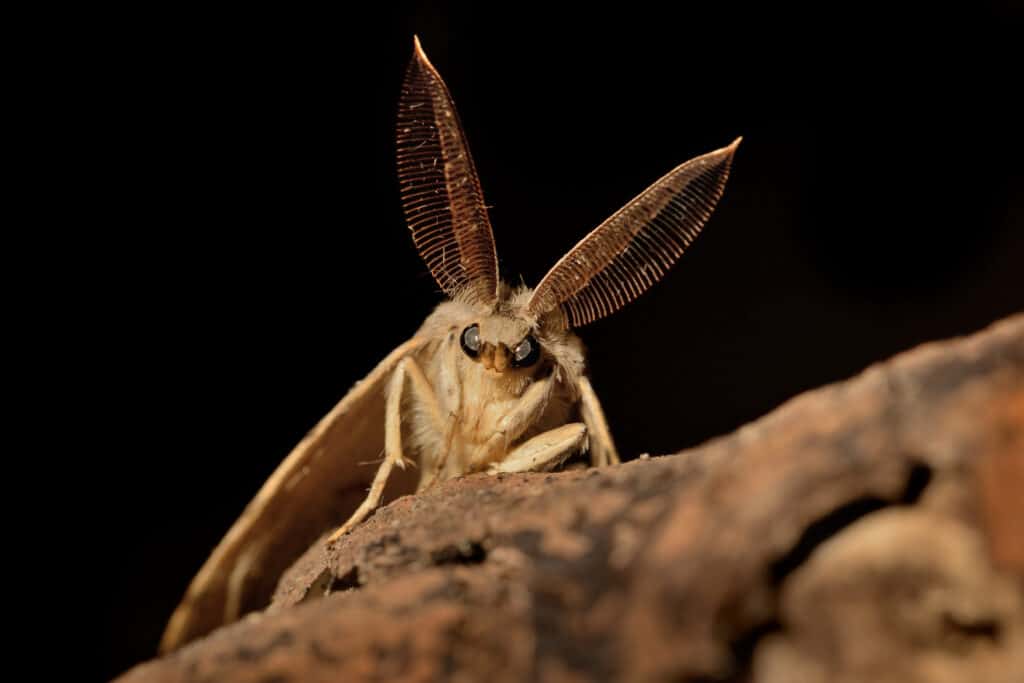
One of the worst forest insect pests in the US, the spongy moth can cause extensive damage to native flora.
©iStock.com/phototrip
The spongy moth is a pest native to Eurasia that was accidentally introduced to the United States. The male spongy moth looks different from the female spongy moth. Male spongy moths have grayish-brown wings with black markings. They have a wingspan of around 1.5 inches. The male spongy month’s antennae are feather-like and are used to detect female pheromones. Female spongy moths, on the other hand, have creamy-white wings with dark sawtooth markings. They have a wingspan of between 2.5 and 3.5 inches. The antennae of the female spongy moth are thin.
The spongy moth is one of the worst forest insect pests in America. The species is invasive because the insect can cause extensive damage to forests, nurseries, vegetation, trees, and shrubs. The spongy moth can also alter wildlife habitats. This moth has caused severe economic costs due to quarantines on timber and agricultural products.
The spongy moth is not established in Washington yet due to eradication efforts. There are annual surveys to locate new introductions and traps placed throughout the state. To stop the spread of this invasive species, take precautions to avoid bringing eggs back into the state. Make sure to follow quarantine rules and avoid transporting any outdoor material from areas with a known infestation.
Apple Maggot Fly (Rhagoletis pomonella)

As evidenced by its name, the apple maggot fly is found on various fruits, including apples.
©Randy Bjorklund/Shutterstock.com
The apple maggot fly is native to North America and is now found in many states across the country, including Washington, where they are considered invasive. These are small flies at only 0.2 to 0.3 inches in length. They have dark-colored bodies with distinctive white bands around their abdomen. There is also a distinctive white spot where the thorax meets the abdomen.
Apple maggot flies eat various fruits, but they are most commonly found on apples, pears, and cherries. The fly will lay its eggs on the surface of these fruits, and the emerging larvae feed on the host. This causes damage to the fruits, rendering them unsuitable for sale. Because this fly lacks any natural predators, it has been able to thrive, and the population of the apple maggot fly has skyrocketed. This has led to a massive economic loss for fruit farmers.
Control methods to control the spread of this invasive insect include sanitizing entire orchards, setting traps to determine when to apply the insecticide, and enforcing strict quarantine regulations for all imported fruits.
Emerald Ash Borer (Agrilus planipennis)

Although not in Washington yet, the emerald ash borer is already considered an invasive species in the state.
©Herman Wong HM/Shutterstock.com
The emerald ash borer is a striking beetle originally from northeastern Asia, including Russia, Mongolia, northern China, Japan, and Korea. These beetles are a beautiful bright metallic green color – this is where the beetle gets its name. Emerald ash borers are small, measuring only 0.33 inches in length and 0.06 inches in width.
Although the emerald ash borer is not yet established in Washington, it is considered an invasive species due to the damage an invasion could cause. The issue is the beetle’s diet. Adult beetles feed on the leaves of ash trees, while the larvae of the beetle feed on vascular tissue under the bark of the ash tree. Because North America does not have resistant trees, predators, and/or parasitoid wasps to control the population of this invasive species, the emerald ash borer continues to reproduce and grow in population. The damage this invasive species is capable of is so vast that it threatens to kill off all the ash trees in North America!
Because the insect can negatively affect the ecosystem and affect native species, control measures must be put in place to stop the invasive species from doing more damage. In Washington, if you find an emerald ash borer, you must report the sighting. Early detection is the best way to prevent an infestation.
Asian Giant Hornet (Vespa mandarinia)

Although recently eradicated, the
Asian giant hornet
is still considered invasive in Washington.
©iStock.com/Bruno Uehara
The Asian giant hornet, or northern giant hornet, is native to Eastern regions of Asia, particularly in Japan, China, and Korea. At 1.5 inches long, these are the largest hornets in the world. The queen can grow to 2 inches long. These aggressive insects have large orange or yellow eyes and a black and white striped body.
Despite the recent eradication of the species, more have taken their place, and the Northern giant hornet is still considered invasive in Washington. The reason for their invasiveness lies in the fact that they can wipe out entire populations of honeybees. This causes extensive damage to many vegetables, fruits, nuts, and even honey production.
Several methods are in place to control the northern giant hornet’s spread in Washington. These methods include trapping, destruction of nests, encouraging the public to report any sightings of the hornet, and raising awareness of the dangers that come with this invasive species.
Spotted Lanternfly (Lycorma delicatula)

Although not yet found in Washington, the spotted lanternfly is an invasive species.
©Amy Lutz/Shutterstock.com
The spotted lanternfly is native to Asia and was first found in North America in 2014. They are small insects about an inch long and half an inch wide. Their wings have black spots with a gray-brown base. Their hind wings are crimson, which gives the insect a red cast.
The spotted lanternfly is not found in Washington yet but is still considered an invasive species. However, the species is prevalent in the eastern United States. The spotted lanternfly feeds on many plants, including tree-of-heaven, apples, cherries, grapes, and more. These insects can also generate honeydew excretions, which can promote mold at the base of trees. The spotted lanternfly feeds on crops and plants by sucking the sap, weakening and damaging the affected plants. This could potentially have devastating impacts, especially in the grape and logging industries.
The control methods for the spotted lanternfly in Washington are mainly prevention. One way to prevent the invasion of this species is to avoid transporting eggs, nymphs, and adult spotted lanternflies from other states. Another method is to steer clear of planting tree-of-heaven on properties.
Yellow Starthistle (Centaurea solstitialis)
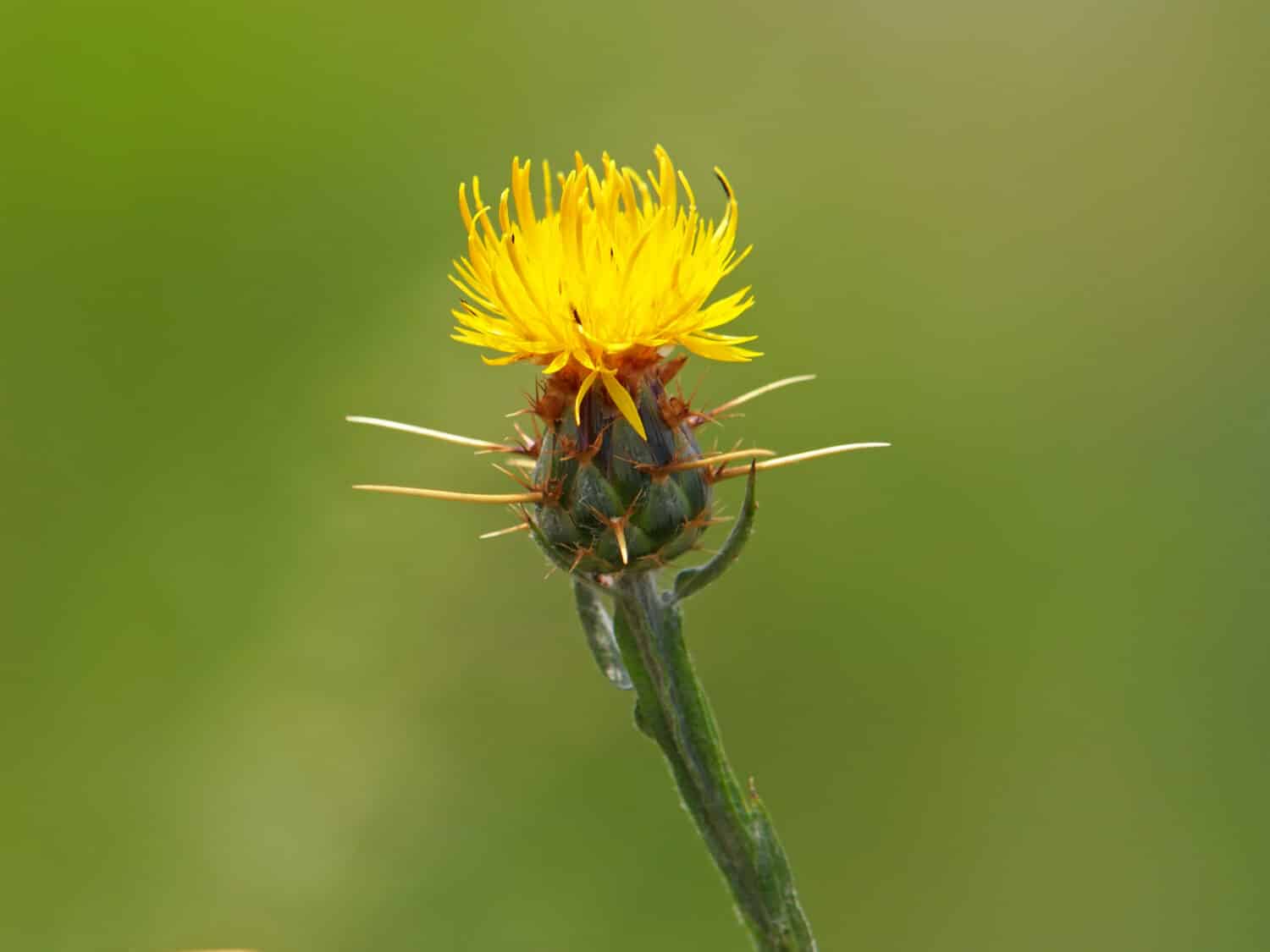
Native to Europe, the yellow starthistle is invasive in Washington as it can poison or kill horses.
©Emilio100/Shutterstock.com
Yellow starthistle is a thorny plant native to Europe, introduced to the United States in the late 1800s. It is a large plant that can grow up to 3.5 feet when flowering. The flowers produced are yellow, and the spines on the plant are between ⅜ and 1 inch long. This plant is capable of producing thousands of seeds. These seeds can remain viable for years, which aids in the plant’s success in invading new areas.
The yellow starthistle is currently found in Washington and is an invasive species due to many reasons. One of the reasons is that the plant provides poor forage to cattle. The plant can also poison or kill horses if large quantities are ingested.
There are few control measures to stop the invasion of yellow starthistle. One way to help is by promoting native species to limit infestations. Because the yellow starthistle is listed as a Class B noxious weed in the state, you can contact your county noxious weed coordinator for assistance if you see this invasive plant.
Saltcedar (Tamarix)
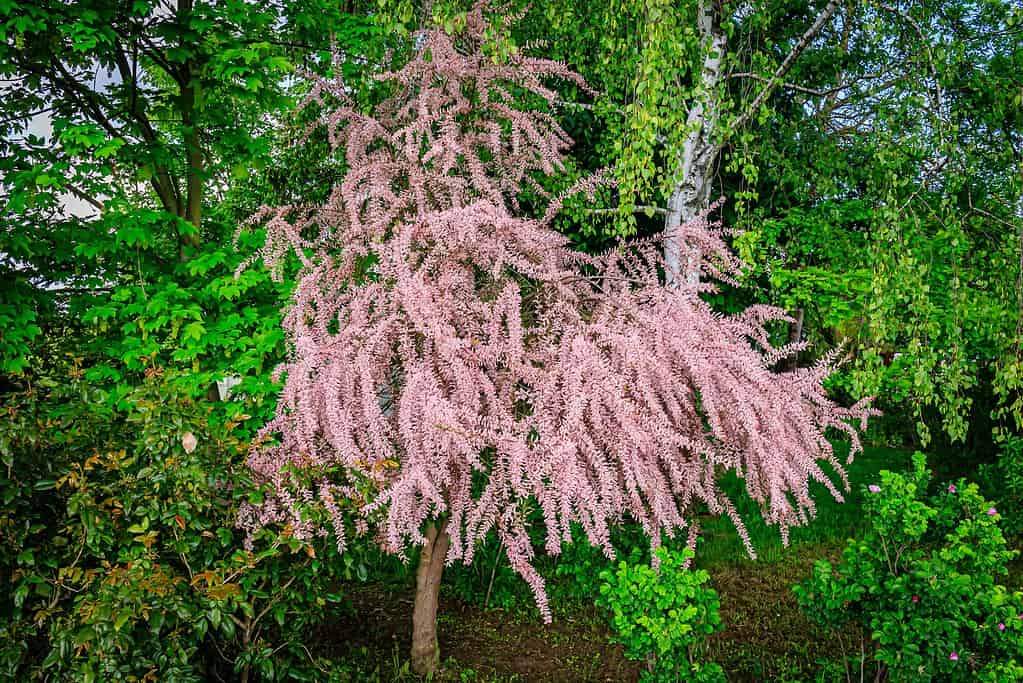
Known as saltcedar or tamarisk, this invasive plant can grow up to 59 feet!
©nnattalli/Shutterstock.com
Saltcedar is a shrub native to Asia and was introduced to the United States for its ornamental and windbreak properties. It is an evergreen plant that can grow up to 59 feet in height! The plant has slender branches and gray-green foliage. The leaves are green and needle-like, while the flowers are pale pink or white.
Saltcedar is found in Washington and is considered an invasive species as it significantly impacts shoreline areas and wetlands. The deep roots of the saltcedar can lower groundwater tables because of its significant water demands. This can also increase soil salinity, which can stress many native plants. Furthermore, the plant increases fire risk and causes flooding. Unfortunately, the saltcedar plant does not have much to offer as it provides poor forage and habitat for native species.
To prevent the spread of saltcedar, cleaning is the way to go. Make sure to clean boots, equipment, tires, etc., that might have touched the plant or seeds. Saltcedar is listed as a Class B noxious weed in the state.
Purple Loosestrife (Lythrum salicaria)
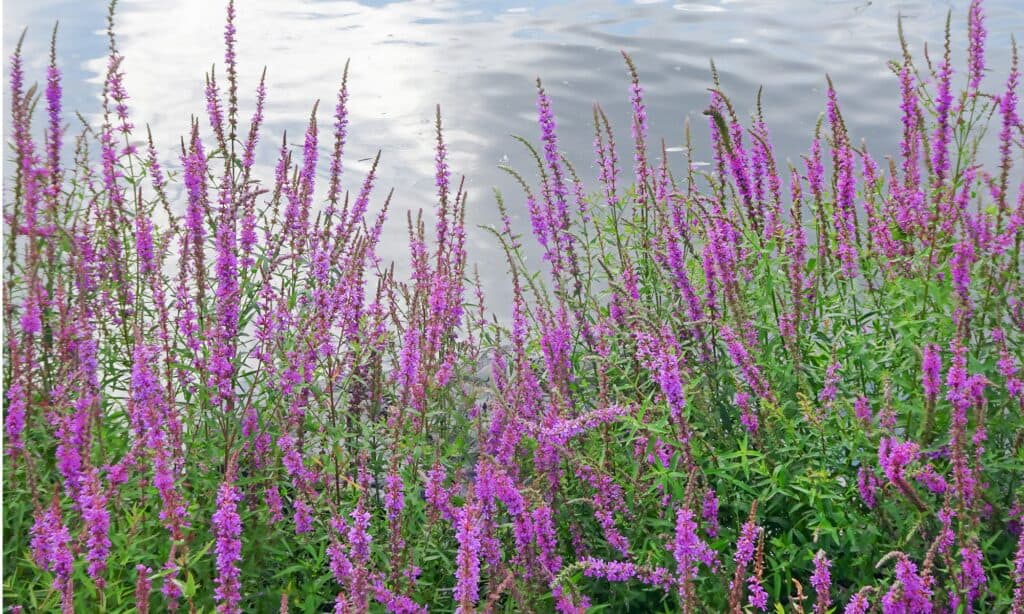
An invasive species, the purple loosestrife outcompetes native plants for resources.
©iStock.com/Natalia Kazarina
The purple loosestrife is a flowering plant native to Europe and Asia. This plant can grow very large – between 3 ft 3 in and 6 ft 7 in tall. This plant can form clonal colonies over 4 ft 11 in wide. The flowers are reddish-purple in color, and the fruit produced is small and contains numerous seeds. The purple loosestrife can be found in wetlands, wet meadows, river banks, stream banks, pond edges, reservoirs, and ditches.
The purple loosestrife is considered an invasive species in Washington due to its ability to outcompete native plants for space, light, and pollinators. The plant also provides poor habitation for species such as waterfowl. Moreover, the purple loosestrife alters the structure and function of the places they inhabit, which can affect agricultural production and reduce forage quality for livestock.
The purple loosestrife is documented throughout Washington and is listed as a Class B noxious weed in the state. To stop the spread of the purple loosestrife, you should avoid planting the purple loosestrife. And if you have it in your garden already, remove it!
Poison Hemlock (Conium maculatum)

An invasive plant species, poison hemlock grows small, clustered, white flowers.
©iStock.com/gabrielabertolini
Poison hemlock is an invasive plant native to parts of Europe, western Asia, and North America and has been introduced to many other parts of the world. The poison hemlock is a highly poisonous herbaceous flowering plant that can live in a variety of environments. This plant can grow up to 8 feet tall and has long, penetrating roots. The poison hemlock also has an odor that is considered unpleasant. The flowers of the plant are small, white, and loosely clustered. To make things worse, every part of this plant is toxic – the seeds and roots of the plant are particularly toxic when ingested.
Poison hemlock is found in Washington and is considered invasive in the state. It is invasive due to its toxicity. In fact, it is capable of killing humans and animals if ingested. Even dead stems can remain toxic for up to 3 years! Each plant can produce up to 40,000 seeds. Because this toxic plant can grow in different environments, it is found in almost every state in the United States.
To control poison hemlock, you can dig or pull out the plant. You must wear gloves before handling the plant, as skin contact can also be toxic. Mowing is not very effective as the poison hemlock can regrow quickly.
Summary of 11 Invasive Species in Washington
| Number | Species | Origin |
|---|---|---|
| 1 | African Clawed Frog | Africa |
| 2 | Northern Pike | North America, Europe, Asia |
| 3 | Spongy Moth | Eurasia |
| 4 | Apple Maggot | North America |
| 5 | Emerald Ash Borer | Northeastern Asia |
| 6 | Northern Giant Hornet | Asia |
| 7 | Spotted Lanternfly | Asia |
| 8 | Yellow Starthistle | Europe |
| 9 | Saltcedar | Asia |
| 10 | Purple Loosestrife | Europe, Asia |
| 11 | Poison Hemlock | Europe, Asia, North America |
The photo featured at the top of this post is © Emilio100/Shutterstock.com
Thank you for reading! Have some feedback for us? Contact the AZ Animals editorial team.






